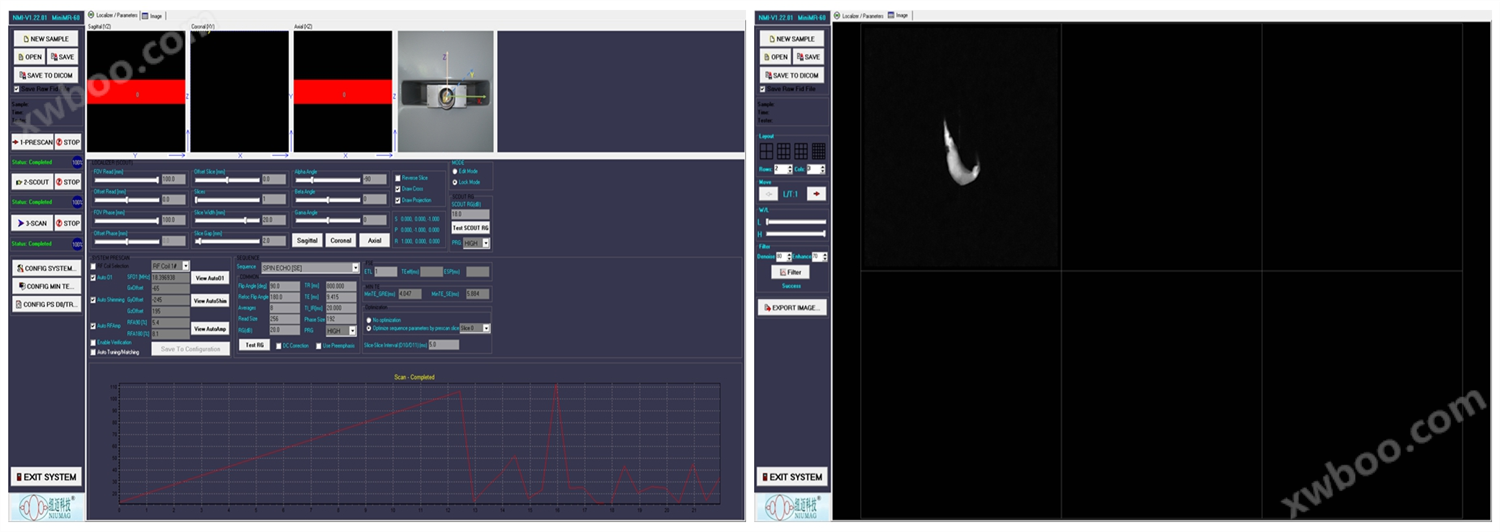Product Description: | | NMI20 seriesMagnetic Resonance Imaging Analyzer (Food)Adopting a modular design that integrates relaxation analysis and magnetic resonance imaging, it won the 2010 Scientific Instrument Innovation Award and has been widely used in food research.Magnetic Resonance Imaging Analyzer (Food)Made with rare earth permanent magnets, with no subsequent maintenance costs; No chemical pretreatment is required during testing, making it convenient and fast; Especially in qualitative and quantitative analysis of water/oil content and binding state, it has unparalleled advantages. The software contains multiple pulse sequences to measure various relaxation times; Using self-developed second-generation spectrometer system and imaging software, it only takes three steps to achieve nuclear magnetic resonance imaging of any layer, angle, and thickness of the sample, which can obtain non-destructive, fast, and intuitive spatial distribution information of water/oil in the sample. | | Product Features: | | Oil and water content detection;
2. Determination of solid fat content (optional);
3. Moisture phase and quantitative analysis;
4. Research on the distribution, migration, and mobility of moisture/oil in water oil systems;
5. Detection of specific pathogenic bacteria in food;
6. Determination of heavy metal ions (Hg2+Cd2+, etc.) in food;
7. Determination of freezing point and unfrozen water content of food;
8. Seed selection, breeding, and developmental process testing;
9. Proton density, T2 weighted, T1 weighted imaging; | | Magnetic Resonance Imaging AnalyzerScope of application: | | 1. Determination of oil and moisture content in oilseeds (ISO10565:1995 GB/T 15690:1995);
2. Determination of solid fat content in pure oil samples (ISO8292 AOCS Cd 16b-93);
3. Research on the quality, processing technology, and storage process of food products (such as meat, seafood, and agricultural products);
4. Seed selection, breeding, and developmental process testing;
5. Evaluation of the drying process of Chinese herbal medicine;
6. Ionic solution and microbial solution;
Test sample requirements: sample height<20 mm, sample outer diameter<12.5 mm; | | Magnetic Resonance Imaging AnalyzerPerformance characteristics: | | 1. Fast: Complete individual sample testing within minutes (depending on sample properties);
2. Non destructive: The sample does not require pre-treatment and is not damaged during testing;
3. Applicability: Wide applicability, no requirements for sample shape or color, solid, liquid, or powder can be used;
4. Operation and use: easy to operate and convenient to use; The imaging adopts automatic optimization parameters, which can complete one imaging in three steps, and can scan at any angle and multiple levels in two dimensions to meet different needs;
5. Easy maintenance: small size, no special requirements for the environment, simple maintenance and management, low cost, no additional consumables (except for glass test tubes); The external unit is equipped with rollers, making it easy to move, and professional technicians can provide remote guidance and equipment maintenance through the internet. | | | | Software Introduction: | | Analyze software interface | | 
| | (1) The interface is simple and easy to operate (Figure 5). Sample relaxation information collection can be achieved in the "Data Collection" interface, and data query, inversion operation, and export can be achieved in the "Data Query" interface;
(2) The "Data Collection" interface provides multiple pulse sequences for selection to meet different sample requirements; | | MRI imaging software: powerful and easy to operate | | 
| | (1) The interface is simple and easy to operate (as shown in Figure 6), and one imaging can be completed in three steps without a deep understanding of nuclear magnetic theory;
(2) Multiple pulse sequence options to meet the needs of different samples; Three imaging angles can be freely selected, and multiple layer scanning can be achieved at once to observe information at different positions inside the sample;
(3) Design adjustable pulse width, pulse amplitude, and trigger time to achieve control over pulse sequences; | | Note: If there are any changes to the appearance of the instrument, the product technical data shall prevail. | |